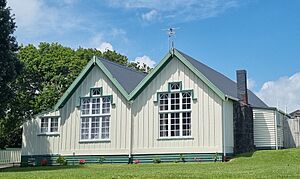Moturoa facts for kids
|
|
||
Moturoa is a coastal suburb of New Plymouth, a city in the western North Island of New Zealand. It is located to the west of the city centre. Moturoa borders Port Taranaki and the Sugar Loaf Islands. One of these islands, Moturoa, is the largest and shares its name with the suburb.
The Ngamotu Domain is south of Moturoa. Mount Moturoa is to the west. Ngamotu Beach is to the north. Moturoa was once known as Tigertown. A book was written in 2007 about its early history.
Contents
History of Moturoa
Early Days and Dicky Barrett
In 1832, Richard (Dicky) Barrett and his friends joined local Māori at Otaka pā in Ngamotu. They helped defend the pā against an attack by heavily armed Waikato Māori. They used three cannons, firing nails, iron scraps, and stones. The defence lasted over three weeks. The Waikato eventually left.
Dicky Barrett and John (Jacky) Love both married into the local iwi (Māori tribes). Jacky Love was the captain of a schooner called Adventure.
Dicky Barrett was a trader, explorer, whaler, and interpreter. He also worked as an agent for the New Zealand Company. After his whaling business faced problems, he helped establish settlers in New Plymouth. Barrett passed away in Moturoa in 1847. He was buried in the Wāitapu urupa (cemetery) near Ngāmotu Beach. This was New Plymouth's first cemetery.
Port and Industry
The natural harbour at Port Taranaki was once called the Port of Moturoa. Small boats carried cargo to larger ships waiting at sea. This continued until the port officially opened in 1881.
In 1865, the Alpha well was drilled near Mikotahi in New Plymouth. This was the first oil well in the Commonwealth. It was also one of the first in the world. An oil industry grew in Moturoa, with wells and refineries. The last refinery closed in 1972. The area still produces small amounts of oil today. Moturoa also had an ironworks, oilworks, a dairy, and a meat cool store.
Public Transport: Trams
New Plymouth had an electric tramway system. It started on March 10, 1916. The trams ran between Fitzroy and Weymouth Street. In the first week, over 18,000 passengers rode the trams. The line extended through Moturoa to the Breakwater at the port in April 1916. The tram system closed on July 23, 1954.
Moturoa Street and Hongi-Hongi Stream
Moturoa Street was once known as Medley Lane. It used to have many houses, but most are now gone. They have been replaced by businesses or empty lots. Locals used to call the street "Melody Lane."
The Hongi-hongi stream starts east of Eton Place. It used to flow into a lagoon and then into the sea at Ngamotu Beach. Dicky Barrett's house was close to this stream. The stream and lagoon were named by "Turi" because of a strong smell. Today, the stream flows underground from Harbour Street to Ngāmotu Beach.
Ngāmotu Beach: A Fun Place
Ngāmotu Beach was once called "The Playshore of the Pacific." New Year's celebrations and carnivals were held there every year. These events attracted large crowds from all over Taranaki. However, their popularity began to decline in the late 1950s. The last carnival was in 1966.
Today, Ngāmotu Beach is home to the 1st Mikotahi Sea Scouts.
Moturoa's Population
Moturoa, including Kawaroa, covers about 2.15 square kilometres. As of 2023, it has an estimated population of about 4,200 people.
In the 2018 New Zealand census, Moturoa had 4,137 people. This was a small increase from previous years. There were more females than males. About 15% of the population was under 15 years old.
Most people in Moturoa are of European descent (Pākehā). About 15% identify as Māori. Other groups include Asian and Pacific peoples. Around 20% of the people were born overseas.
Many people in Moturoa (49%) said they had no religion. About 38% were Christian. Other religions included Hindu, Muslim, and Buddhist.
Education in Moturoa
Moturoa School is a primary school for students in years 1-6. It has about 200 students. The school celebrated its 75th anniversary in 1998. Since 2006, it has also hosted two primary classes from the New Plymouth Montessori school. Moturoa School was the first Enviroschool in Taranaki. It has achieved a Silver award level for its environmental efforts.
Sports in Moturoa
Association Football (Soccer)
Moturoa is home to Moturoa AFC, a soccer club. The Execel Refrigeration Moturoa AFC women's team recently qualified for the 2024 Women's Central League. They won their promotion play-off game 2-1 against Horowhenua Coastal.
Rugby League
The Western Suburbs Tigers Rugby League Club is based at the Ngamotu Domain in Moturoa.
Rugby Union
The Moturoa Football Club was a short-lived rugby union club. It started in 1914. The team trained at the prison reserve field. The club later joined with the Star Rugby Football Club. They kept a junior team that played in white, Moturoa's colour.
Cricket
The Moturoa Beachcombers was a cricket team in the 1910s. They played against other local teams. In 1911, they even travelled by motor launch to play a game in Urenui.



